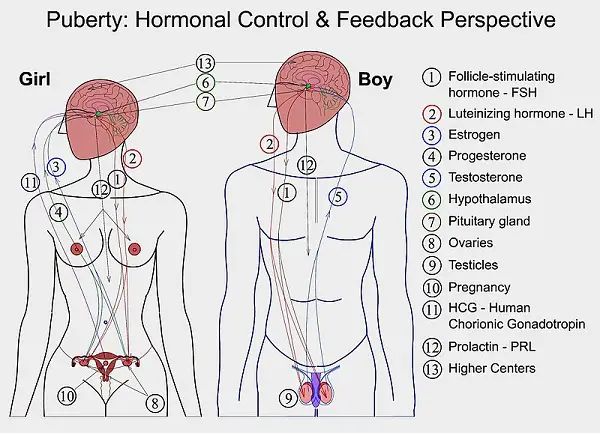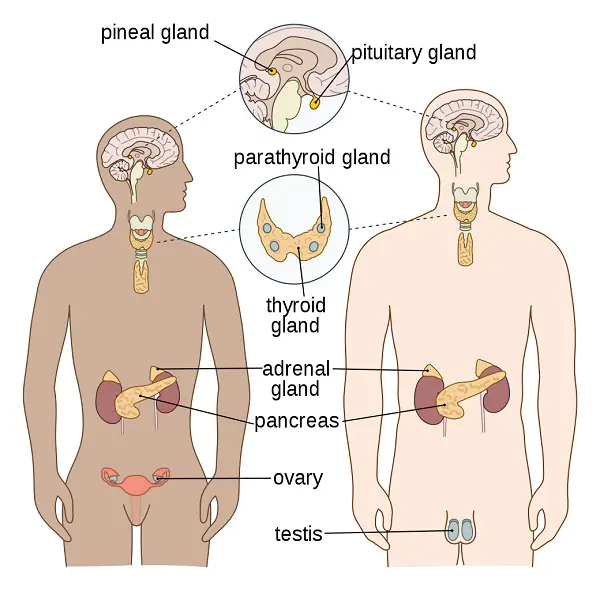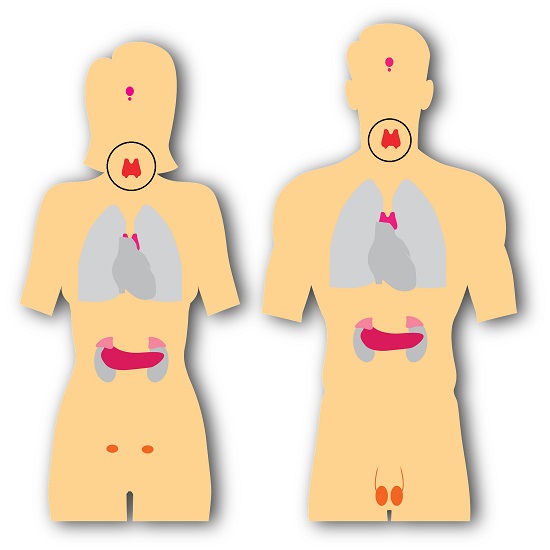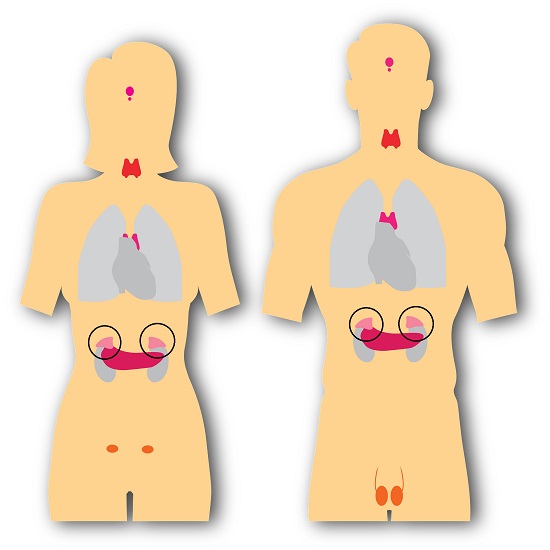Endocrine System
The endocrine system secretes hormones that regulate body activities, thus maintaining homeostasis. Learn more about hormones and the endocrine system that controls them in this reviewer.
Table of Contents
- Hormones and the Endocrine System
- Hormone Signaling and Hormone Properties
- The Vertebrate Endocrine System
- Download Article in PDF Format.
- Test Yourself!
Hormones and the Endocrine System
In order to maintain homeostasis and carry out coordinated functions, the cells must communicate with each other. They do so by sending chemical and electric signals by way of two systems. The first of which we will tackle in this article: the endocrine system.
The endocrine system is made of interacting glands and tissues that produce and secrete chemicals to initiate and maintain body functions. Endocrine cells release chemical signals called hormones, which travel the bloodstream to all parts of the body. This system is well suited for gradual changes that affect the entire body. Hormones also regulate long-term developmental processes such as the physical and behavioral changes that accompany sexual maturity (like puberty).

Hormones are made and secreted mainly by endocrine glands. These glands contain endocrine cells that secrete hormone molecules that diffuse into the blood vessels until they reach certain types of cells, called target cells, which have receptors to the specific hormone.
Depending on the location of the target cells, the hormone can take effect on a single location in the body or in sites throughout it. Certain cells and signals are shared by the endocrine system with the nervous system. Specialized neurons called neurosecretory cells perform in both systems.
Hormone Signaling and Hormone Properties
Hormone signaling has three stages: reception, signal transduction, and response.
Reception occurs when a hormone binds to a specific receptor in the target cell. The binding triggers events within the cell (signal transduction) that convert the signal molecule from one form to another.
The result is the response, a change in the cell’s behavior. Heart muscle cells respond to epinephrine by contraction (speeding up heartbeat) while on liver cells, epinephrine causes the organ to break down glycogen, providing the body with glucose.
Hormones can be classified based on chemical properties into two groups: Water-soluble hormones and lipid-soluble hormones. Most hormones produced by endocrine glands are water-soluble while a few endocrine glands are able to produce lipid-soluble membranes. The latter include steroid hormones which are made from cholesterol. We will now take a closer look at the different endocrine glands that make up our body.
The Vertebrate Endocrine System
Some endocrine glands are specialists that primarily secrete hormones into the blood while other glands serve additional nonendocrine functions. Still, there are organs that are mainly nonendocrine but have cells that secrete hormones (the stomach, for example, secretes the hormone gastrin).
What stimulates an endocrine gland to produce a hormone? For some glands, a change in levels of certain ions or nutrients is the stimulus while others need orders from the nervous system. Hormones can also stimulate endocrine glands to secrete other hormones too.

OpenStax, Tomáš Kebert, and umimeto.org. Licensed under CC BY-SA 4.0.
The hormones produced by the endocrine glands have a wide range of effects. Here are the major endocrine glands (in bold text) in the body and some hormones (italicized) they are able to secrete:
In the brain, these endocrine glands are present:
- Pineal Gland
- Melatonin – regulates the biological rhythm. Most associated with sleeping pattern
- Hypothalamus
- Multiple hormones
- Pituitary Gland – is divided into the:
- Anterior Pituitary
- Numerous Hormones
- Posterior Pituitary
- Oxytocin – stimulates contraction of the uterus and mammary gland cells
- ADH – helps the kidneys retain more water
- Anterior Pituitary
In the throat we have:
- Thyroid Gland
- Thyroid Hormone (TH) – stimulates and maintains metabolic processes
- Calcitonin – lowers blood calcium levels
- Parathyroid Glands
- Parathyroid Hormone (PTH) – raises blood calcium levels
Other endocrine glands include:
- Pancreas
- Insulin – lowers blood sugar level
- Glucagon – raises the blood sugar level
- Adrenal Gland (above the kidneys) has the following components:
- Adrenal Medulla
- Epinephrine and Norepinephrine – raise blood glucose levels and metabolic activities; constrict certain blood vessels
- Adrenal Cortex
- Glucocorticoids – raise blood glucose levels
- Mineralocorticoids – increases blood volume and blood pressure
- Adrenal Medulla
- Testes
- Androgens – support sperm formation, promotes the development of male secondary sex characteristics
- Ovaries
- Estrogens – stimulate the growth of the uterine lining, promotes the development of female secondary sex characteristics
- Progesterone – promotes uterine lining growth
Androgens, estrogens, and progesterone are found in both sexes but play a major role in one sex than the other (normally). We will take a closer look at the different endocrine glands.
Endocrine Glands in the Brain
The pineal gland is a pea-sized tissue near the center of the brain which secretes melatonin, a hormone that links light with our body’s biological rhythm, particularly the sleep-wake circadian rhythms. Sometimes called the “dark hormone,” melatonin is secreted at night and plays a role in promoting sleep.
The hypothalamus plays an important role in integrating the nervous and endocrine systems. Hormones produced by the hypothalamus directly control the pituitary gland, which in turn secretes hormones that influence numerous body functions. Think of the hypothalamus as a CEO directing the company’s managers, with the hypothalamus relaying directives to other glands through the pituitary.

The pea-sized pituitary gland is made of two distinct parts: a posterior lobe and an anterior lobe. The posterior pituitary is composed of nervous tissue and is an extension of the hypothalamus. It stores and secretes two hormones synthesized in the hypothalamus. The anterior pituitary is an endocrine gland that both synthesizes and secretes hormones.
The neurosecretory cells in the hypothalamus synthesize oxytocin and antidiuretic hormones (ADH). These hormones are channeled and stored in the posterior pituitary. These hormones are released into the blood vessels when they are required. Oxytocin causes uterine muscles to contract during childbirth and mammary glands to eject milk during nursing. ADH helps the kidneys reabsorb water.
The second set of neurosecretory cells in the hypothalamus secrete two other kinds of hormones into blood vessels that connect to the anterior pituitary: the releasing hormone (RH) and an inhibiting hormone. The former stimulates the anterior to secrete one or more specific hormones and the latter acts to stop the anterior pituitary in secreting hormones.
Many hormones are secreted from the anterior pituitary which also stimulates other endocrine glands to produce other hormones. These include the thyroid-stimulating hormone (TSH) which stimulates the thyroid gland and its metabolic effects; the adrenocorticotropic hormone (ACTH) stimulates the adrenal cortex which affects water balance and metabolism; and follicle-stimulating hormone (FSH) and luteinizing hormone (LH) stimulate the testes and ovaries to produce reproductive hormones. Unlike the other hormones, prolactin (PRL) does not lead to the secretion of other hormones, and in mammals, this hormone stimulates the production of milk.
One pituitary hormone with very broad effects is growth hormone (GH). It promotes protein synthesis and the use of body fat for energy metabolism. GH also promotes the development and enlargement of all parts of the body. Continued high levels of GH during childhood can lead to a condition known as gigantism whereas too little of it will lead to dwarfism.
The hypothalamus produces specific RHs for specific endocrine glands. A feedback control mechanism controls the release of the different hormone cascades. For example, the hypothalamus will create a releasing hormone for TSH known as TRH (TSH-releasing hormone, bear with the acronyms since the entire topic will have lots of them) that stimulates the anterior pituitary to produce TSH, leading to the thyroid gland to secrete thyroid hormones.
When the thyroid hormone reaches a certain level in the blood, it signals the hypothalamus and anterior pituitary to inhibit TRH and TSH secretion and in turn, thyroid hormone secretion.
Hormones are essential for homeostasis. How other hormones play a role in this process will be our next concern.
Thyroid Hormones

We mentioned the thyroid gland a while ago. The gland is located in the neck, just below the voice box. The gland secretes thyroid hormone which performs several important homeostatic functions and stimulates the metabolism in all the tissues of the body.
The thyroid hormone is actually a pair of hormones: thyroxine (T4) and triiodothyronine (T3) with the number designation referring to the number of iodine atoms the hormones contain.
Thyroid hormones are important in the development of bone and nerve cells, and in maintaining blood pressure, heart rate, muscle tone, and a lot of other functions related to metabolism.
An excess of thyroid hormone in the blood (hyperthyroidism) can make a person overheat, sweat a lot, become irritable, with the most common form of hyperthyroidism manifesting as Graves’ disease, the hallmark sign of which is protruding eyes caused by fluid accumulation behind the eyeballs.
Conversely, insufficient levels of thyroid hormone (hypothyroidism) can cause weight gain, lethargy, and intolerance to cold. Hypothyroidism can also come from dietary disorders. Insufficient iodine in the diet can cause goiter, an enlargement of the thyroid glands.
Sex Hormones

The gonads secrete sex hormones in addition to producing gametes (egg and sperm cells). We will tackle the role of sex hormones on the next chapter. For now, we’re going to highlight that the gonads of mammals produce three major categories of steroid sex hormones: estrogens, progesterone, and androgens.
Estrogens maintain the female reproductive system and promote the development of female secondary sexual features. Meanwhile, progesterone is involved in preparing and maintaining the uterus to support an embryo. Lastly, androgens stimulate the development and maintenance of the male reproductive system with testosterone being the main androgen.
Pancreatic Hormones

The pancreas has two functions: it secretes digestive enzymes into the small intestine, and it secretes hormones that regulate blood glucose levels. The two main hormones are insulin and glucagon, both having antagonistic effects on each other.
Beta cells in the pancreas release the hormone insulin. When blood glucose levels elevate and stimulate the pancreas, the effect of insulin is the uptake of glucose from the blood leading to a decrease in blood glucose levels. Glucagon opposes the effect of insulin and is released by alpha cells in the pancreas. Glucagon causes glycogen to break down into glucose to be released into the blood.
The Adrenal Glands

Two adrenal glands are located on top of each kidney. The gland is made up of two fused glands: a central portion known as the adrenal medulla and an outer portion which is the adrenal cortex. Both portions secrete hormones that respond to stress.
The adrenal medulla secretes hormones that prepare the body for sudden action and ensure a rapid response. These are epinephrine (which is more familiar to us as adrenaline) and norepinephrine.
The adrenal cortex, meanwhile, responds to stressful conditions such as low blood sugar or blood pressure. While the adrenal medulla responds to nerve signals, the adrenal cortex responds to hormone signals.
Adrenocorticotropic hormone (ACTH) stimulates the adrenal cortex to synthesize and secrete steroid hormones called corticosteroids, which in humans are divided into mineralocorticoids and glucocorticoids. The former mainly acts on salt and water balance while the latter mobilizes cellular fuel, such as promoting glucose production from noncarbohydrates.
An important feature of life is passing on traits and biological information. This function is central to the reproductive organs which we will take on next.
Next topic: Reproductive System (and the Embryonic Development)
Previous topic: Urinary System
Return to the main article: Animal Form and Functions (Overview)
Download Article in PDF Format.
Test Yourself!
1. Practice Questions [PDF Download]
2. Answer Key [PDF Download]
Copyright Notice
All materials contained on this site are protected by the Republic of the Philippines copyright law and may not be reproduced, distributed, transmitted, displayed, published, or broadcast without the prior written permission of filipiknow.net or in the case of third party materials, the owner of that content. You may not alter or remove any trademark, copyright, or other notice from copies of the content. Be warned that we have already reported and helped terminate several websites and YouTube channels for blatantly stealing our content. If you wish to use filipiknow.net content for commercial purposes, such as for content syndication, etc., please contact us at legal(at)filipiknow(dot)net